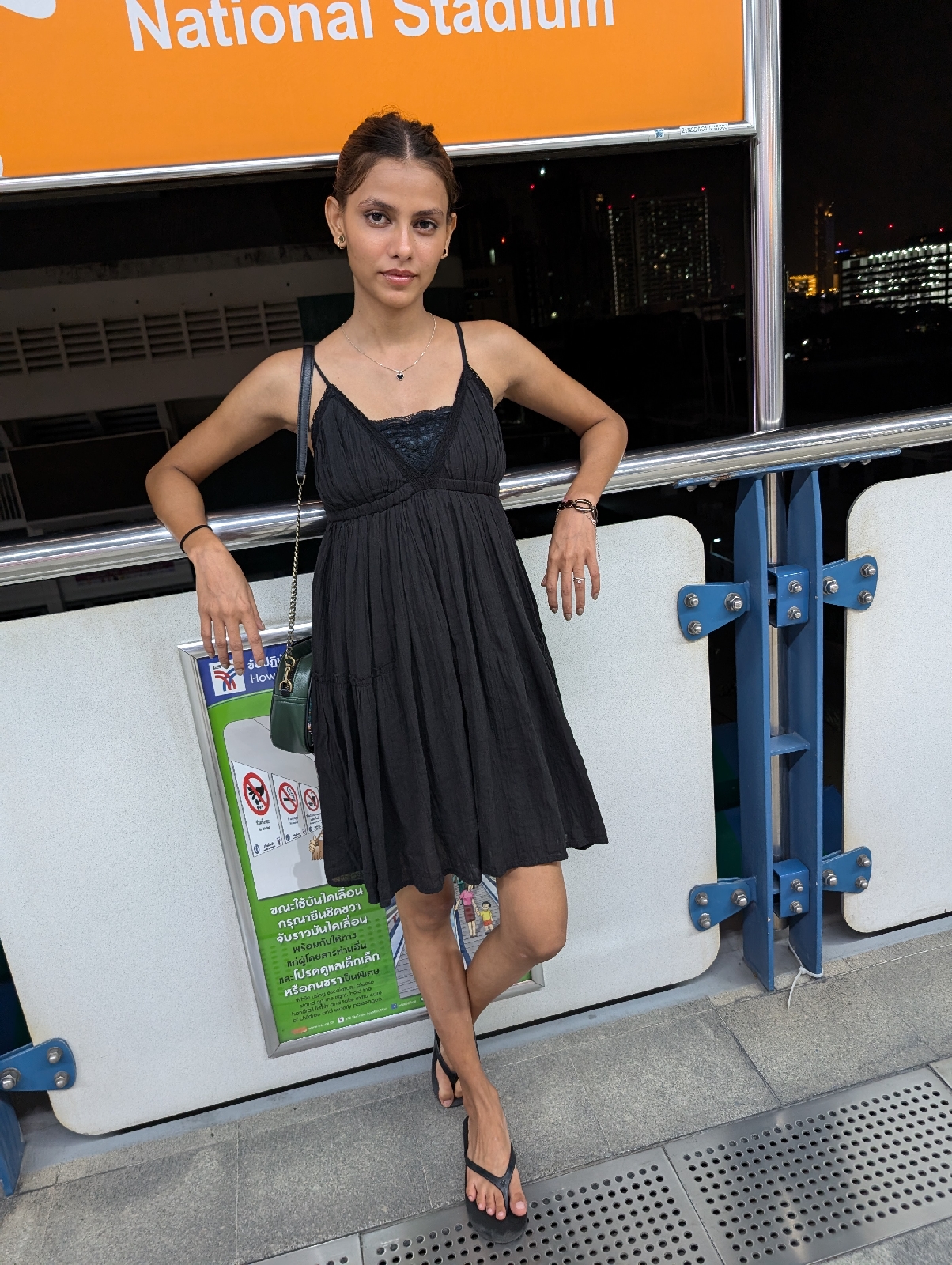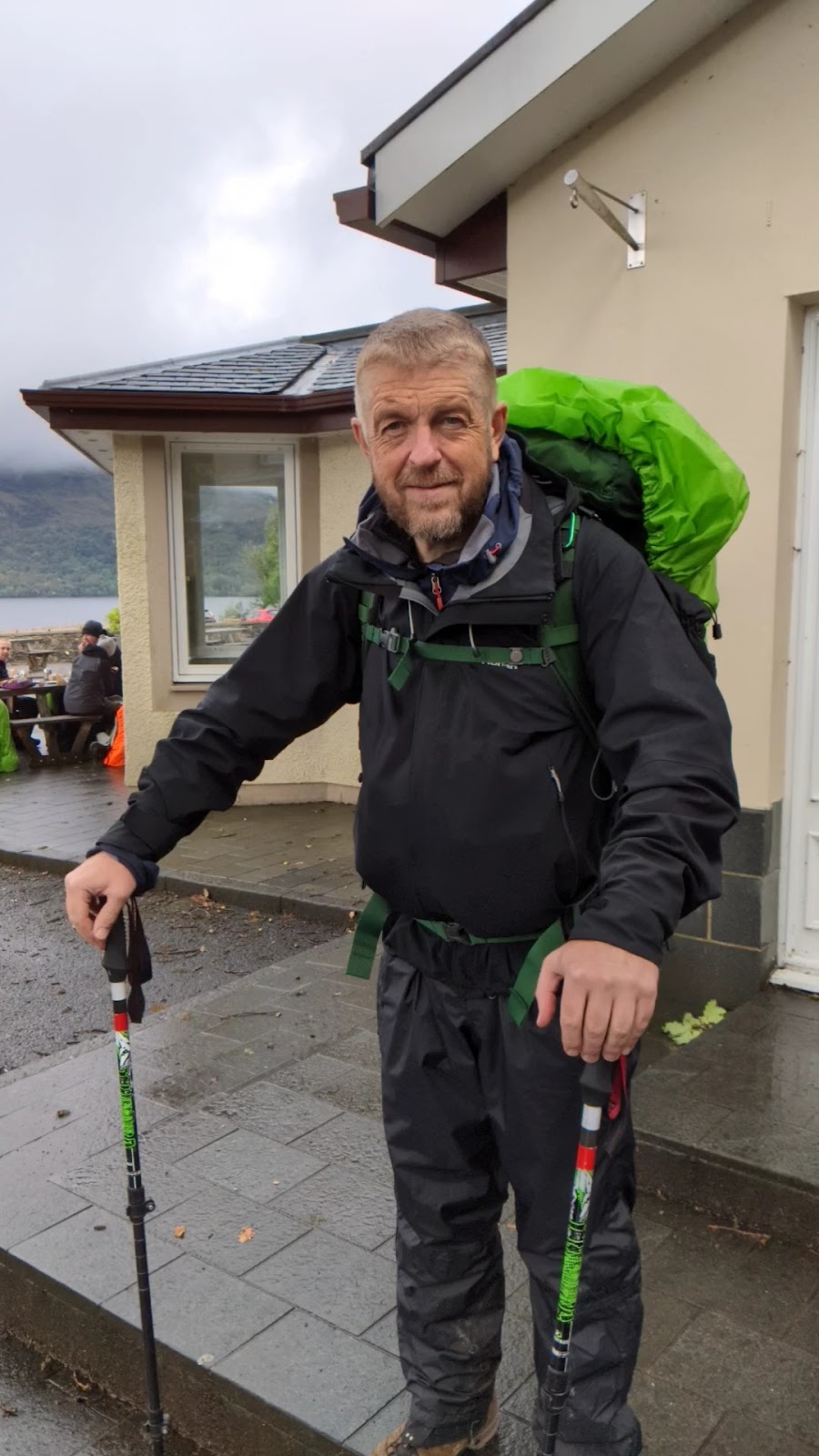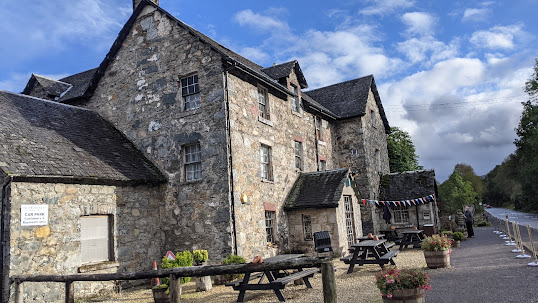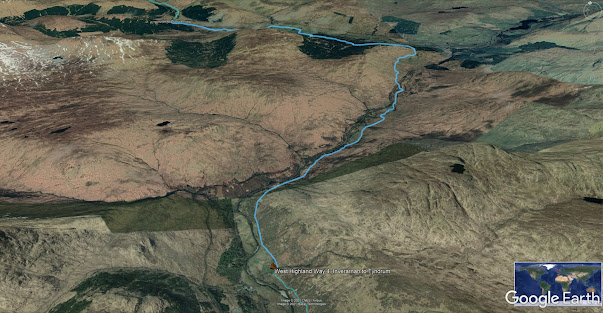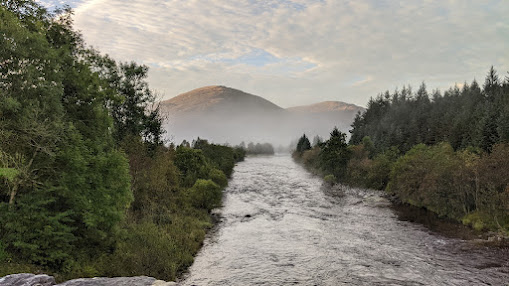As I was leaving my guesthouse the manager told me that for the next two days there will be no shops or towns. He recommended that I stop in the local grocery store, Brodies Mini Market, to buy whatever supplies I needed.
Brodies had a wonderful supply of candy bars, canned goods, white bread, and not much else. Fortunately, I had purchased nuts and dried fruit in Milngavie so I thought I would be okay. Still, I purchased something that looked like a piece of pizza wrapped in plastic.
Today's path was an old military road. About 1750 the British decided that if they were going to squash the local rebellions they needed a road system that would allow them to rapidly move troops around Scotland.
They didn't do such a bad job and it was certainly much better than the awful path around Loch Lomond.
I only met one man, his wife, and their dog for the entire day. As I approach them, I saw that the man was holding a bottle of whiskey and two plastic shot glasses.
He didn't say hello. Instead, he said, " 'Ave a wee bit 'a whiskey."
"No thank you, I've got to keep walking."
"Aw come on mawn, you're in Scotland.
"To me, it tastes like mouthwash."
"You haven't had real Scotch whiskey then."
"How about tonight? I need someone to introduce me to Scottish whiskey."
"Okay then, tonight."
I saw them again later as I was taking a break. They were traveling with a 14-month-old Labrador Retriever that he said was very well trained and would never make a mess in a hotel. The hotels, by the way, make a point of advertising if they are dog friendly. A surprisingly large number of people walk with their dogs.
Besides their dog, I met some other animals on the path, none of whom were shy at all about having their picture taken.
I made some very baa-aa-d sheep noises to get this guy to look at me.
He never moved.
These guys are known for being gentle. Nevertheless, it was an adventure to photograph them.
Forest management in Scotland appears to be somewhat patchy.
I arrived at my hotel for the night, the Bridge of Orchy, an hour before check-in but the nice lady at the desk let me check in anyway. I have no complaints about the room.
Just out the door is, you guessed it, the bridge of Orchy.
The bridge was built about 1750 so that the British could keep their troops dry.
Day 6 Bridge of Orchy to Kingshouse
Every hotel has either given me a packed lunch or breakfast. Today it was breakfast. Having breakfast in my hotel hasn't meant getting on the trail much later in the day because it doesn't really get light until 8:00 a.m. anyway.
looking upstream while standing on the bridge of Orchy
From across the bridge, the path led up through hills to a summit that I arrived at just as the sun was coming over the larger ridges -- giving me an incredibly wonderful view of Rannoch Moor below. "This is, "I thought, "why people come to Scotland."
From there the path led down to a paved modern road for a kilometer or so and then turned off the paved road into what looked like an unused and abandoned motorway.
This sign explained the old road; the text from the sign is below.
Telford's Parliamentary Roads
Before the end of the 18th century, the military roads in the highlands were falling into a state of disrepair, which made them unsuitable for the increasing commercial traffic.
"I was commissioned in 1803 by the government to build new roads and bridges in the highlands. The new roads I have designed have gentler gradients. Being lower on the hillside they require larger bridges to cross the burns. Box culverts are used instead of cobbled fords to reduce the damage to carriage springs. For the general well-being and value of the cattle and sheep being driven to market, I insist that the road be constructed with a good depth of gravel to prevent damage to their hooves."
The road went out of use as the main public road in 1933 but is still in good condition today as it is maintained for estate access and the West Highland Way.
Telson did an amazing job with solid stone bridges and excellent drainage. It was really far superior to that stupid military road I walked on yesterday. My Gawd, everybody knows that the military can't build good roads.
I'd been walking for two hours when I took a break to eat a snack and drink some water. When I stood up, just a few meters behind me was the first black woman I have seen in Scotland.
Her skin was black, I mean coal-black, and she dressed in black, topping that off with black sunglasses. I was immediately attracted to her.
Janet is from Sacramento, California, and is here with four other American women who have been doing the walk since Milngavie. Janet joined them today.
She kept a fierce pace that completely energized me as I tried to keep up with her. When I commented on how fit she was, she agreed and told me that when she is in California every day she jogs five miles. She was sure that she would never need to take a break at any time during the day.
What an easy path to walk on.
When she stopped to take some pictures, I kept walking, knowing that she would eventually catch up with me. She did.
Meeting her again, I asked her if I could ask her to do me a favor. She said yes and I began:
"In my small town in Ohio, the only neighbors I like are two black guys, a father, and his son.
The father is retired but his son has a full-time job and saves a lot of money.
"One day I asked the young guy what he was going to do with his money. He said he didn't know. I suggested doing some hiking to which his father said, "Black people don't hike."
"So could you pose for a picture with me?"
She said yes.
After about 3 and a half hours of walking, I was sure that we were probably at least halfway to our lodging for the night when Janet and I walked by a ski lodge. Standing outside was a tourist who agreed to take our picture.
When we walked to the other side of the ski lodge, much to my surprise I saw that we were at the Kingshouse Hotel, our destination for the night.
This is the fanciest place yet. There are two bars, a giant dining area, and luxurious rooms that they wouldn't let me enter until 3 PM, at which time I had been sitting in the dining room for two hours.
(The man who offered me the free whiskey the other day told me that if I stayed in the Kingshouse Hotel I had to have money. I guess he was right. He was walking on to the next village.)
Outside the grounds of the hotel/ski resort was a sign saying that camping was only allowed across the river in the moorland. And sure enough, just outside my window, there was a guy camping. If you look closely, you can see his dog.
Waking up in the morning, it was lightly raining and the camper, having put a raincoat on his dog, was packing up his tent. He disappeared by the time I went to breakfast.
Oh, by the way, if by chance, any of the pictures you've seen on this blog look like scenes from a movie that is because they probably are. These are some of the movies that have been filmed here in the Highlands:
Being Human
Braveheart
Bonnie Prince Charlie
Harry Potter and the Prisoner of Azkaban
Highlander 1 and 3
Kidnapped
Monty Python and the Holy Grail
Rob Roy
The 39 Steps
and
So with so much going for it, why don't more people live here? According to the guidebook, more people don't live here because of a tiny insect called a midge. A midge is like a mosquito, except it doesn't stick its nose in you: it bites. They are fiercest in the summer, but even now many places still sell head nets that appear to offer some protection.
More than one hiker has told me, "The rain and cold are a damn-sight better than the midges."
Day 7 King's House to Kinlochleven
Leaving the monstrous hotel, the countryside was spooky. The stark mountains that could clearly be seen the day before were now covered in clouds and mist to make everything dark, grey, and silent. There wasn't a bird or an insect to be heard.
The path ran about 100 meters parallel to a major highway for 40 minutes or so and then turned away from the highway to begin a long series of switchbacks up the hills. It was another of these old British military roads. The switchbacks were cursed by the British foot soldiers who had to carry heavy artillery up them. They nicknamed them "the devil's staircase."
It was quite a slog. Not only that, but by this time it was raining heavily. Soon, of course, my feet became wet and gradually everything else became wet as well. Fortunately by this time I know that happiness in Scotland is walking with wet cold feet and I was getting happier by the minute.
Up and up.
As I trudged upward, a man and a woman who had wild camped the night before passed me. The man told me that while they were sleeping the deer had come to check out their tent. The man heard them, crawled out to see what they were doing and the deer didn't move as he locked his flashlight into their eyes. After that, their tent started leaking. This time they both went outside to put Vaseline over the leaking seams. Gradually, they said, the leaks stopped. I complimented them on their resilience. They seemed energetic and enthusiastic about the hike and quickly passed me.
 the wild campers passing me
the wild campers passing me
crossing small streams meant jumping from stone to stone and occasionally missing a stone
When I stopped for lunch the path was still going up and it was still raining. As I ate my nuts and dried fruit, I realized that I was quickly losing body heat and that I shouldn't stop again if I didn't want to get hypothermia.
Fortunately, soon the switchbacks started going downhill.
Coming down through the hills, which became forested, the path passed a damn that had a series of monstrous pipes leading down from it to the final stop of the day -- the old aluminum processing town of Kinlochleven.
The entire town had been built by the British Aluminium Company to house 700 workers who processed aluminum with electricity generated by the water flowing out of the giant pipes. When the factory closed in 2000 the town reinvented itself as a center of outdoor recreation and today one of the old factory buildings has Europe's biggest ice climbing training wall.
the guidebook described Kinlochleven as Scotland's ugliest village,
but I thought that it had some charm.
None of that made any difference to me when I arrived wet and cold two hours before my guesthouse was going to begin checking people in.
I looked for some kind of shelter to get out of the rain-- a picnic pavilion or an unused storefront and didn't find a thing. Finally, I did a Google maps search for a pub. I found one, stumbled in, followed directions to leave my backpack in the doorway, and ordered a bowl of hot lentil soup. I ate the entire bowl of soup without saying anything to the hiker who was sitting next to me and who seemed to be drinking one pint of beer after another. When I finally did say hello to him, he told me that he was waiting for his guesthouse to open as well; he added that he just couldn't stop shivering or shaking from the cold. I told him that that was exactly how I felt.
My travel agency had booked me into the Allt Na Leven Guesthouse only after the guesthouse that I had originally been booked into was closed because of COVID-19. The couple who run the Allt Leven Na were doing everything they could to make sure they weren't going to be the next guesthouse closed because of COVID-19. When I stepped in, the manager, from a few meters away and wearing a mask, told me to take my jacket and my boots off and put them in a plastic laundry basket that she had placed on the floor between us. I followed instructions. She told me that she would put them in her drying room, and return them to me later.
Besides that, she told me that she would appreciate it if I stayed in my room and didn't venture into her lounge/dining area until tomorrow morning.
I followed her directions and only made the briefest of exits from her guest house just before dark to grab a sandwich and a beer from the shop across the street.
Day 8: Kinlochleven to Fort William
I overslept today and had the same nightmare that I always have while traveling: I'm on a bus and when I get off, I leave my bag on the bus. What a relief to wake up and find my bag on the floor.
At breakfast, the other hikers commented on how awful yesterday had been. Apparently, because I had arrived earlier in the afternoon, the path hadn't yet become the small stream that hikers found later in the day.
After breakfast, I found my jacket and shoes that the manager had put in her drying room, (a room with a humidifier and a slightly warmer temperature) wonderfully dry.
As I walked out of town I met the man who had offered me free whiskey a few days ago. He remembered me very well and he kept repeating my name with his very Scottish lilt, "Good ya morning Tom Riddle, and how is Tom Riddle feeling this morning?"
"I'm still dry."
His luck had run out yesterday. As he had come down the devil's staircase, the sole of one of his boots completely separated from the rest of the boot. So he and his wife were going to take a bus home. As we parted, he let me take their picture.
The path started off looking like the devil's staircase part two.
Fortunately, it wasn't raining and after a few switchbacks, I was out of the forest.
looking back at Kinlochleven
In the 1700s the British forced many of the local people out of the area to prevent any possible rebellions. It is remembered (depending on who is telling the story) as ethnic cleansing.
The ruins of some of their homes can still be seen.
Someone told me that the United Kingdom, UK, should be called the BUK, the Barely United Kingdom. Here that means that the Scots have never forgiven the British for being repressive colonials. A few miles west of here in the village of Glencoe is the site of a particularly brutal incident. In August of 1691, the English king told the local chiefs to take an oath of allegiance before January 1 of the following year. Unfortunately one of the chiefs, Alexander MacDonald, didn't take his oath until January 6. Always ones for punctuality, the English sent 100 soldiers to the MacDonalds to teach them some manners. The MacDonald clan hosted those soldiers for a week or so at which time the British massacred 38 of their hosts. Now, 330 years later the Scots haven't forgiven or forgotten what happened. I saw a sign along the path today to remind me.
After three pleasant hours of walking, I sat down to eat my lunch, and just as I finished, it started raining again. But by then I knew that I just had two more hours of walking before I would arrive at Fort William and the end of the walk.
In the distance is the tallest mountain in Britain, Ben Nevis. The clouds never cleared enough for me to see it clearly. People can walk to the top and back down in a day.
The last couple miles of the West Highland Way was kind of a disappointment in that the path becomes a sidewalk beside a busy road. If that wasn't bad enough, the path used to officially end at the edge of Fort William, but now, thanks to some clever city planning, it ends at the far end of the main shopping street where there is a made-for-pictures statue.
 The made-for-pictures statue above, and me, below, holding a walking stick making a picture.
The made-for-pictures statue above, and me, below, holding a walking stick making a picture.
I had talked to this couple a few times during the hike. They were very friendly, and as far as I could tell at every stop the first thing they did was have a beer or a whiskey, which is exactly what I would have done if I had done the walk with another person. The man told me that the hike had been bad for his liver.
After the picture, we parted and I retraced my steps back through the main shopping street which contained a variety of Scottish whiskey shops, camping stores, souvenir shops, and stores selling every kind of wool garment imaginable. Clearly, tourism is big business here.
After a shower and changing into dry clothes, I knew that this was it and there was no going back: tonight I was going to drink Scotch whiskey. I asked the manager of my guesthouse if she could recommend a local bar that specialized in Scotch whiskey. She suggested that I try one or two of the thirty-five different whiskeys in her whiskey closet, just beside the lounge. That sounded much better than going back out in the rain.
She was very enthusiastic. Whiskey in Scotland, I quickly learned, is like wine in France or beer in Milwaukee: it is a way of life and the pride of the nation. She told me that occasionally she will host German whiskey clubs who are touring Scotland and trying Scotches from some of the 130 distilleries.
Before she served me she gave me precise instructions. I was first to enjoy the smell of the golden brown liquid, then I needed to swish it around my mouth, letting all of the subtle flavors sink in. Food, with whiskey, as well as ice, was forbidden. A person should seriously, meditatively if you will, slowly savor and enjoy every sip and then let the palate and throat savor the after taste.
I carefully followed instructions and after two 35 ml drams, it became clear that drinking Scottish whiskey was a wonderful way to enjoy an evening. It would be very easy to make a habit out of it.
Epilogue
I woke up the next morning clear-headed and wished that I had not made a train reservation for Edinburgh--I was ready for one more day of walking--this time up to the top of England's tallest mountain, Ben Nevis. That wish ended when I looked out the window and learned the weather forecast: 100% chance of rain.








